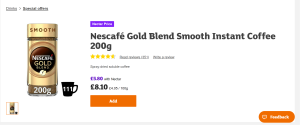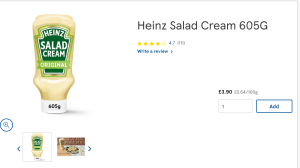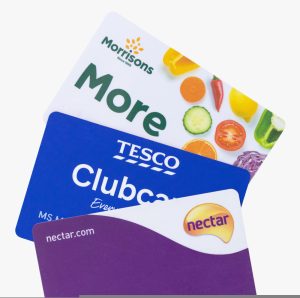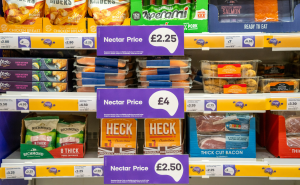As we move into the new year, we take a look at Grocery Gazette’s best bits of 2023. Today, we look back on Which? claims that “potentially dodgy tactics” are being used on supermarket loyalty offers, and whether the criticism is valid.
Food inflation is falling, but with prices remaining high across a vast range of products in UK supermarkets, it’s unsurprising that consumers are looking to retailer loyalty schemes to save some extra cash.
Supermarkets have also been ramping up their offerings, adding special ‘bonus’ deals and slashing prices for members.
However, research published by consumer watchdog Which? in September suggests that supermarkets, including Tesco and Sainsbury’s, could be using deceiving tactics to give the impression their loyalty scheme savings are better than they really are.
And since this article has been published, the CMA has revealed it will open an investigation into loyalty card price cuts amid concerns they could limit competition and lead to price rises for those not signed up to the schemes.
At a time when every penny counts for much of the population, we take a look into these claims, if they tell the full story and if shoppers can actually trust supermarket loyalty schemes.

Earlier this month, Which? said that supermarkets are opting for “potentially dodgy tactics on loyalty offers” to present their savings in the best light after tracking 141 Clubcard and Nectar Price offers promoted online by Tesco and Sainsbury’s for six months until the end of June.
The watchdog found that 29% of the member-only promotions across both supermarkets were at their ‘regular’ price less than half the time.
It said that the Nectar price of Nescafe Gold Blend at Sainsbury’s was £6 and its regular price was £8.10.

However, this had only become the standard price just two days before the Nectar price launched – before that, it was £6. The £8.10 regular price also places it at £1.10 more than any other supermarket.
One example at Tesco was on Heinz Salad Cream which had a Clubcard price of £3.50 and a regular price of £3.90. The regular price had been £2.99 for several weeks before it increased to £3.90 just 22 days before the Clubcard promotion.

Which? has called on supermarkets to make sure every non-member price is genuinely reflected so that savings are meaningful.
However, Sainsbury’s said that the price rises came as a result of inflation.
Tesco said its Clubcard Price promotions followed strict rules, and that all deals were compared against prices at other supermarkets to ensure they represented genuine value and savings.

Retail specialist Phil McMahon says that the findings presented by Which? raise valid concerns and says the supermarkets may need to review their internal processes.
“The supermarkets have naturally defended their respective positions but their internal processes for setting prices may need to be reviewed, and we already know inflation has been the major challenge in 2023.
“While inflation might explain some of the price increases, it does not necessarily explain the timing of these increases in relation to member-only price schemes and so the supermarkets might find it prudent to ensure that ‘regular’ prices have been in place for a widely acceptable minimum period before items qualify for member-only price schemes.”
However, he believes this to be “genuine oversights rather than malice on the part of Tesco and Sainsbury’s”.
McMahon says that unfair pricing practices “simply carry too great a risk in the UK’s ultra-competitive grocery industry”, adding “shoppers would be unlikely to forgive any proven price-gouging during an economic crisis, and there are plenty of other supermarkets to switch to”.
Marketing consultant Danny Denhard agrees that although prices fluctuate, “the timing and packaging of these price changes could be more transparent”.
He adds that Which?’s research highlights something that has happened for a long time but is “now being packaged slightly differently”.
“One of the big misconceptions with members-only pricing is that the price is not always hugely lower than weeks before. Commonly the prices do increase before reduction or revert back to the original price it was being sold for. This happens from fashion to food, unfortunately as it is food and drink it can feel more disingenuous.”

According to Denhard, it’s highly unlikely.
“I don’t believe trust has been impacted as much as the headlines will make out. As long as there are savings and everyday essentials continue to drop in price, most shoppers won’t need additional marketing messages from their supermarkets.
“Loyalty schemes as a whole are good for customers and good for business.”
GlobalData associate retail analyst Joe Dawson agrees that Which?’s findings are unlikely to have a substantial effect on Tesco or Sainsbury’s customer base as “they still manage to maintain price matches with most other supermarkets that do not have as comprehensive a member prices scheme”.
McMahon says that living in “an era of declining trust”, retailers that offer member-only pricing should “get ahead of any potential misunderstandings or accusations by actively communicating to customers what the criteria are for items to quality for their individual schemes”.
“Maximum transparency should be the norm; it build’s trust, and will ultimately be reflected at the tills.”

While many analysts believe that there is more to the story, with factors such as inflation impacting loyalty schemes prices, Which? raised concerns that the schemes can be intrusive and exclude certain groups.
One point raised by Which? was the issue of exclusivity as you have to be 18 or over to be a member of Asda, Iceland, Lidl, M&S, Sainsbury’s, Tesco and Waitrose’s loyalty schemes.
McMahon believes that this does create challenges as younger individuals, school children buying lunch or teenage parents “may not have access to discounts that were previously universal”.
“I think any reasonable person would feel that isn’t right,” he says. “It would be worth retailers re-evaluating the exclusivity of member-only pricing, ensuring that it does not inadvertently disadvantage or discriminate against certain sections of the population.
“Supermarkets are not immune to genuine oversights or the need to review policies over time, so I think it’s only fair to raise concerns and give them an opportunity to respond and act before passing judgement.”
Another issue raised by Which? was the fact that the general loyalty scheme model aims to aggregate customer data and share it with other organisations, ultimately excluding those who do not wish to share their data from signing up.
Dawson says that this data exchange is “a trade off”. “As long as consumers understand what they are signing up to, it should not be an issue,” he adds.
“It is true that for those unwilling to share their data with supermarkets it will be more difficult to find low prices, but supermarkets have been under great pressure to cut prices and have often taken on losses to do so, so it is understandable to expect something in exchange.”
Sainsbury’s told Which?: “We make every effort to be transparent about how customer data is used at Nectar.”
It is unlikely that shoppers will turn away from the discounts offered in supermarket loyalty schemes, particularly during the cost-of-living crisis. But with the CMA’s investigation into whether loyalty scheme pricing limits competition opening this month, there may be more twists and turns to this story.